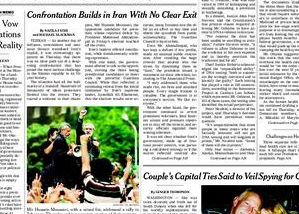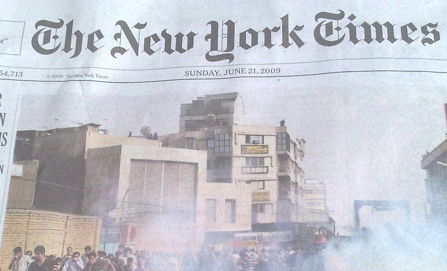Following our round-up of the Westminster students coverage of last week’s Journalism in Crisis conference, we’ll link to one final item:
Professor Todd Gitlin’s keynote speech, given via Skype, on the first day of the Westminster University / British Journalism Review Journalism in Crisis event (May 19): ‘A Surfeit of Crises: Circulation, Revenue, Attention, Authority, and Deference’.
Gitlin, who is professor of journalism and sociology at Columbia University, talked about how four wolves have arrived at the door of journalism ‘simultaneously, while a fifth has already been lurking for some time’. These were the wolves no-one was expecting, because everyone’s been crying wolf for so long. Gitlin spoke mainly in regards to American journalism because ‘it is what I know best’.
He used quotes and statistics from the Pew Project for Excellence in Journalism ‘Changing Newsroom’ 2008 report, and also his own anecdotal evidence and academic references, to illustrate the predicament – which he feels is fair to call a number of ‘crises’ – that journalism faces.
Here are a few choice extracts:
- The four wolves at the door, and the fifth one lurking: “One is the precipitous decline in the circulation of newspapers. The second is the decline in advertising revenue, which, combined with the first, has badly damaged the profitability of newspapers. The third, contributing to the first, is the diffusion of attention. The fourth is the more elusive crisis of authority. The fifth, a perennial – so much so as to be perhaps a condition more than a crisis – is journalism’s inability or unwillingness to penetrate the veil of obfuscation behind which power conducts its risky business.”
- Circulation of newspapers: “Overall, newspaper circulation has dropped 13.5 per cent for the dailies and 17.3 per cent for the Sunday editions since 2001; almost 5 per cent just in 2008. In what some are calling the Great Recession, advertising revenue is down – 23 per cent over the last two years – even as paper costs are up. Nearly one out of every five journalists working for newspapers in 2001 is now gone. Foreign bureaus have been shuttered – all those of the Boston Globe, for example, New England’s major paper.
- “I have been speaking about newspapers’ recent decline, but to limit the discussion to the last decade or so both overstates the precipitous danger and understates the magnitude of a secular crisis—which is probably a protracted crisis in the way in which people know—or believe they know—the world. In the US, newspaper circulation has been declining, per capita, at a constant rate since 1960. The young are not reading the papers. While they say they ‘look’ at the papers online, it is not clear how much looking they do.”
- “The newspaper was always a tool for simultaneity (you don’t so much read a paper as swim around in it, McLuhan was fond of saying) at least as much as a tool for cognitive sequence. What if the sensibility that is now consolidating itself—with the Internet, mobile phones, GPS, Facebook and Twitter and so on – the media for the Daily Me, for point-to-point and many-to-many transmission—what if all this portends an irreversible sea-change in the very conditions of successful business?”
- The Clamor for Attention: “Attention has been migrating from slower access to faster; from concentration to multitasking; from the textual to the visual and the auditory, and toward multi-media combinations. Multitasking alters cognitive patterns. Attention attenuates. Advertisers have for decades talked about the need to ‘break through the clutter,’ the clutter consisting, amusingly, of everyone else’s attempts to break through the clutter. Now, media and not just messages clutter.”
- “Just under one-fifth of Americans between the ages of 18 and 34 claim to look at a daily newspaper – which is not to say how much of it they read. The average American newspaper reader is 55 years old. Of course significant numbers of readers are accessing – which is not to say reading – newspapers online, but the amount of time they seem to spend there is bifurcated. In roughly half of the top 30 newspaper sites, readership is steady or falling. Still, ‘of the top 5 online newspapers – ranked by unique users – [the] three [national papers] reported growth in the average time spent per person: NYTimes.com, USAToday.com, and the Wall Street Journal Online.’ One thing is clear: Whatever the readership online, it is not profitable.”
- “The question that remains, the question that makes serious journalists tremble in the U. S., is: Who is going to pay for serious reporting? For the sorts of investigations that went on last year, for example, into the background of the surprise Republican nominee for Vice President, Gov. Sarah Palin of Alaska.”
- Authority: “Journalism’s legitimacy crisis has two overlapping sources: ideological disaffection from right and left, and generalized distrust. Between them, they register something of a cultural sea change. The authority of American journalism has, for a century or so, rested on its claim to objectivity and a popular belief that that claim is justified. These claims are weakening.”
- Deference: “We have seen in recent years two devastating failures to report the world – devastating not simply in their abject professional failures but in that they made for frictionless glides into catastrophe. The first was in the run-up to the Iraq war (…) More recently, we have the run-up to the financial crisis (…) Given these grave failures of journalism even when it was operating at greater strength not so long ago, one might say that rampant distrust is a reasonable and even a good thing.”
- Resolutions: “The Project on Excellence’s conclusion is that ‘roughly half of the downturn in the last year was cyclical, that is, related to the economic downturn. But the cyclical problems are almost certain to worsen in 2009 and make managing the structural problems all the more difficult.’ Notice the reference to ‘managing the structural problems.’ They cannot be solved, they can only be managed. The unavoidable likelihood, pending a bolt from the blue, is that the demand for journalism will continue to decline and that no business model can compensate for its declining marketability. No meeting of newspaper people is complete these days without a call – some anguished, some confident – for a ‘new business model’ that would apply to the online ‘paper.’ The call has been issued over the course of years now. It might be premature to say so, but one might suspect that it has not been found because there is none to be found.”
- “What I do know is that journalism is too important to be left to those business interests. Leaving it to the myopic, inept, greedy, unlucky, and floundering managers of the nation’s newspapers to rescue journalism on their own would be like leaving it to the investment wizards at the American International Group (AIG), Citibank, and Goldman Sachs, to create a workable, just global credit system on the strength of their good will, their hard-earned knowledge, and their fidelity to the public good.”
Full transcript at this link…



